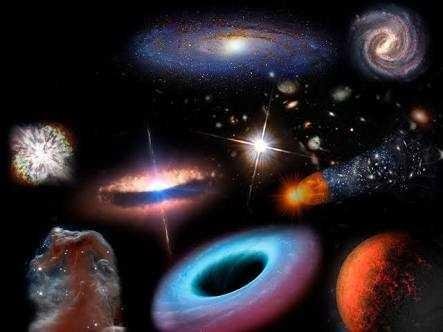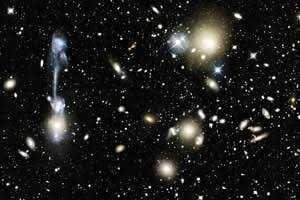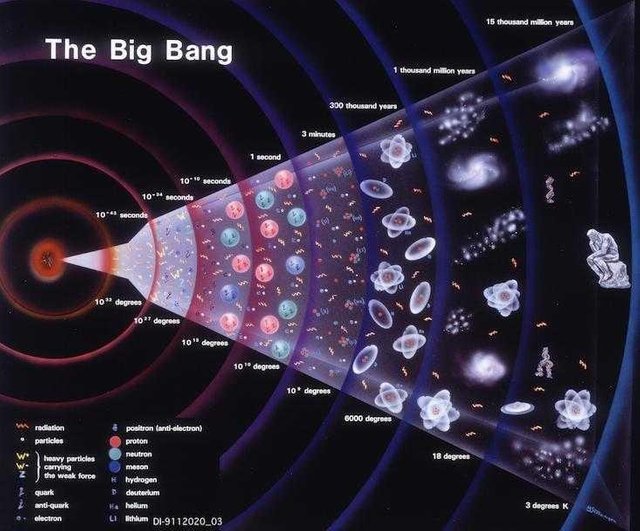The Galaxies Should Be Closer To The Past
Where is the end of the sky? We discuss how widespread the universe, that is long enough, is divided into several parts. Earth is a planet, a small world that moves in orbit around a half-old star, The sun's distance from the earth is about 149.6 million km (1 unit astronomy = 1 au).

The nearest neighbor of the earth is the moon that surrounds the earth with a period of 27.3 days. The average distance between the earth and the moon is 384,400 km, measured from the center of the earth to the center of the moon, about the same distance as ten journeys along the equator of the earth. The furthest planet is Neptune, which averages about 30 au from the sun.
Compared to the scale of the Solar System, the distance between stars is amazing. The nearest star is bigger than 250,000 times the distance of the sun to the earth. Therefore, a better way to feel the distance in the universe is to use the unit, how long the light travels a certain distance. With a light speed of 300,000 km per second, the light takes 1.3 seconds to reach the Moon, 8.3 minutes to reach the sun, and 4.1 hours to reach neptune. The nearest star is Proxima Centauri which is 4.2 light-years away.

The Sun is a large archipelago of stars, gas, and dust known as the Galaxy. Galaxy called the Milky Way contains more than 100 billion stars, spread in disc-shaped systems that have a diameter of about 100,000 light years. With egocentric conventions, we are referring to our own star system as Galaxy. Far outside our galaxy is scattered billions of other small galaxies. Some spirals like our own Galaxies, some are elliptical, and some are irregular, which have no particular shape. Because it lies deep outside our galaxy, this galaxy is sometimes referred to as extragalaction or outer galaxies. The nearest outer galaxy is called Andromeda which has the M31 catalog number. The size of this galaxy is almost the same as our galaxy, and is about 2.2 million light-years away.
In the universe, galaxies are distributed in lumps. Like our own Galaxy, it is a member of a small group of twenty galaxies of members. Others are grouped into large groups of hundreds, or even thousands of member galaxies. And this group reunited into a larger structure called supercluster, which covers the size of 100 million light years or more, and contains thousands or tens of thousands of galaxies. The Local Group of our galaxy is located on the outskirts of the Virgo supercluster, whose center is located about 50 million light-years away.
The most luminous object so far detected is a quasar, an object that looks like a star, but it emits hundreds of strong light, or even thousands of times the light emitted by normal galaxies. The most distant quasar currently detected, is at a greater distance, 13 billion light years.
The first observations were made by Edwin Hubble. Shows that all the galaxies and clusters outside the Local Group away from the earth, and also away from each other, at speeds proportional to the distances that are farther away, this fact shows that the entire universe is expanding and also means that the galaxy is so close to each other in the past compared to the present. The development of the universe began with a massive explosion called the Big Bang. Sequentially the galaxy is formed from the starting material and then pulled out by the development of the universe.

The universe is huge in the scale of space and time. The light reaches our telescope from the farthest galaxy, and the quasar has spread through the cosmo far longer than the earth's own time. If we look at these distant objects, we really look back in time, how they look when the universe is still a small part of the present.
The Law of Hubble Law says that the velocity of the galaxy (v), is directly proportional to the distance from us (d). The formula is v = Hd. In this formula, H is the Hubble constant. The Hubble constant is very important, because it gives the speed of the expanding universe. This constant is also used in Hubble's Law to describe the distance of the galaxy by measuring its redshift. Determining H accurately is actually very difficult, because of the uncertainty in the scale of the distance of extragalaction. Prices taken range from 50 to 100 km/sec/Mpc or 15 to 30 km/second/million light years.
Estimated age standards of the universe are based on Hubble's constant price. Hubble's time, the age of the universe since the Big Bang is proportional to 1 / H, of which 10 to 20 billion years. Although there are still many problems and many unanswered questions, it seems that the development of this universe began about 13.7 billion years ago. Meanwhile, the approximate radius of the universe also depends on the price of the Hubble constant. Hubble's radius, whose distance to the observable universe, is proportional to the speed of light divided by the Hubble constant, c / H, and also depends on the model of its natural universe. Estimates now produce a universe radius that is between 12 billion to 16 billion light years.

Note: All letters and numbers are mine, but the picture I got from google, I just use it to connect from my writing.
You just planted 0.02 tree(s)!
Thanks to @youngky
We have planted already 5488.36 trees
out of 1,000,000
Let's save and restore Abongphen Highland Forest
in Cameroonian village Kedjom-Keku!
Plant trees with @treeplanter and get paid for it!
My Steem Power = 20590.37
Thanks a lot!
@martin.mikes coordinator of @kedjom-keku
This post has received a 1.61 % upvote from @speedvoter thanks to: @youngky.
This post has received a 0.24 % upvote from @drotto thanks to: @youngky.
You got a 0.82% upvote from @mercurybot courtesy of @youngky!
This post has received a 4.32% upvote from @msp-bidbot thanks to: @youngky. Delegate SP to this public bot and get paid daily: 50SP, 100SP, 250SP, 500SP, 1000SP, 5000SP Don't delegate so much that you have less than 50SP left on your account.
You got a 1.18% upvote from @minnowvotes courtesy of @youngky!